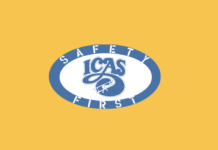In the summer of 2007, the air show industry was stunned by a series of horrific accidents. For many of us in the safety arena, this catastrophic turn of events led to an extended period of quiet introspection and sobering discussions with colleagues. What we found worried us; the safety-first mantra of ICAS had slipped from top-of-mind thinking to the back burner…the way-back burner.
We considered a lot of questions about the why’s, how’s and when’s that eventually were reduced to a couple of universals: 1) our industry was not talking/thinking about safety nearly as much as we should, much less on an everyday basis; 2) we were all watching the ultra aggressive/no safety margin type of flying flourish without voicing our collective concerns; and, 3) everyone was involved; performers, event organizers, air bosses; everybody. The industry had a big problem.
The first step in solving any problem is to recognize that you have a problem. The weekends of tragedy were our industry’s wake-up call that we had a problem, and –luckily — we got it. The second step was to create a workable plan to solve it. Enter the five E’s: Engage; Educate; Embrace; Enforce; Employ.
Implementing the first three E’s turned out to be easier than expected. It quickly became apparent that the industry wanted, even expected ICAS to take the lead in addressing our industry’s safety-related challenges.
We began by reviewing the “givens” that had evolved, asking all the questions that had somehow become taboo. Had we knowingly accepted higher levels of risk or had that additional risk snuck in while we weren’t paying attention? Had our laser-like focus on protecting spectators created a laissez faire attitude as it related to risks that did not involve the audience? Had event organizers abdicated their responsibility to work in partnership with performers to identify and mitigate risk? Were we accepting increased levels of risk to gain competitive advantage in the air show marketplace and, if so, why?
The entire demonstration/presentation/control/management regimen was being revisited, reviewed and engaged. Oh yeah, it got intense, event heated at times. But what we discovered was that the industry badly needed to develop a far-reaching safety education program that would include all facets of the air show community: performers, event organizers, support services.
Fortuitously, a synergistic commitment of the membership, committee members, board of directors and staff members recognized the appropriate jumping off point for this new initiative: the annual ICAS Convention. It began with a very public commitment during the 2007 ICAS Convention that the organization would allocate its resources to restoring a “safety first” mindset within the business. It was followed, during the annual performer safety de-brief at that same convention, by a very clinical discussion of the year’s fatal accidents that sought to address our industry’s safety shortcomings directly and constructively.
And the payback was virtually instantaneous. Almost before the 2007 ICAS Convention was over, one could sense that the majority of the ICAS members were buying into the idea that safety should be returned to top of mind awareness within the air show community. Our membership had embraced the initiative and made it their own. This was not a top-down mandate. We were seeing a genuine shift in how individual air show professionals were looking at their role in improving air show safety.
A year later during the 2008 ICAS Convention, the event included substantive committee updates, seminar sessions and accident debriefings that demonstrated that there was a clear path to mitigating risk and improving safety in the air show environment. ICAS introduced its new, full-time director of safety and operations to the membership. We explained the work that had been done by the new Safety Management System Committee during the previous year.
By then, safety was on everybody’s mind. Now the hard work of instituting the programs began. Two of the E’s were left, enforcement and employment.
Nobody likes to be the cop. It ain’t fun. But air show professionals have discovered during the last three years that a true change in the culture of air show safety means that we must all accept some enforcement responsibility. Aerobatic Competency Evaluators (ACEs) must be willing to say no to prospective air show pilots who don’t yet possess the requisite skill set. All of our performers must be willing to chat with colleagues if they see them doing something unsafe. Air bosses must be willing to say, “No” when “No” needs to be said. Event organizers must commit themselves to creating an air show environment that mitigates risk and promotes safety above all other considerations. We must all embrace the responsibility for grassroots enforcement. If we do not, we risk attracting the uninvited, sometimes invasive attention of regulators who may not necessarily share our interest in achieving the right balance of safety and showmanship.
Our industry’s commitment to the Safety Management System (SMS) philosophy has helped ICAS produce programs, processes and systems designed to identify risk and initiate action to eliminate or mitigate that risk. ICAS has developed and regularly distributes the ICAS Operations Bulletin (Ops Bull) Newsletter to put simple, concise safety information into the hands of our members on a regular basis, both to maintain top-of-mind awareness on safety issues and provide members with simple, practical safety tips. We now have a program that allows an ICAS member to report, anonymously, if so desired, questionable activities, rules violations, erratic performances, or any other activity that threatens air show safety. (Visit https://www.airshows.aero/docs/ICARUS%20MASTER.pdf to download the form that you may use to report potentially unsafe incidents). We also have a separate, carefully constructed and effective system in place to objectively and consistently investigate safety incidents or accidents within the air show community. In each case, the systems include mechanisms to share this information with other air show professionals so that they can learn from these incidents. As important, these systems are being successfully used on a regular basis.
Employment is the most sensitive of our five “Es.” Within the air show community, “extreme air show flying” had captured the eye of the event organizers, despite that fact that – by and large – the audience does not recognize or appreciate the additional danger. The audience does not understand the physiological demands of 10 G maneuvers. They don’t recognize the danger of dangerously thin safety margins at the bottom of aggressive maneuvers. There was an unspoken understanding in the business that the more extreme style of flying had very little to do with spectators and was primarily a tool for getting hired by event organizers. A certain type of demand creates a certain type of supply. An absence of that demand will, inevitably, reduce the supply.
So, almost three years later, how are we doing? Well, things are moving forward swiftly and the pendulum has definitely swung. Safety is still very prominent in most folks’ thinking. We have a full time Director of Operations and Safety at ICAS headquarters. The SMS philosophy has been embraced throughout the industry. We have developed and are developing a number of “best practice” documents to help identify how, as an industry, we expect things to be done. Safety incidents are being investigated on a more consistent and objective basis. Information is being shared within the industry on a more systematic and regular basis. Safety is a more frequent and serious topic of discussion among industry professionals. And it appears all of this activity is having the desired impact on overall safety within the industry.
Of course, we still have much to do. We have not yet fully engaged the membership with their issues and input. Although we are making good progress, we have a backlog of “best practice” projects to initiate and finish. And there are still some obvious, gaping holes in our industry’s safety program. But the numbers speak for themselves. Thanks to everybody, we’re doin’ good. But we must always be aware and on guard, lest the pendulum starts back in the other direction.
Don’t do nuthin’ dumb!








